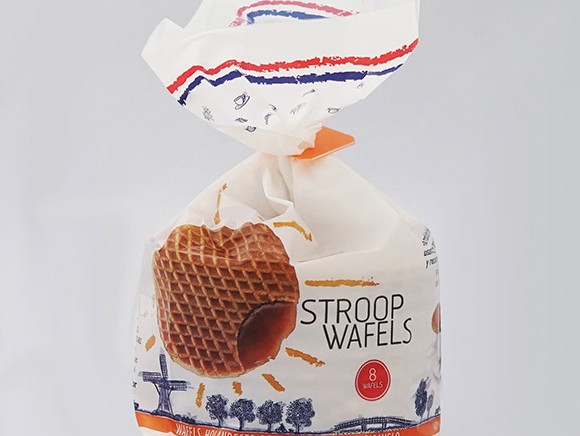
Making stroopwafels the Ecuadorian way: Eric van Maasdijk (45) is making these Dutch delights—brown sugar syrup sandwiched between two thin layers of biscuit-sized waffles—in the South American country's capital city of Quito, 2800 metres above sea level. It is an adventure with local ingredients, a different cooking temperature and figuring out how to keep your wares as fresh as possible.
"The thin air in Quito substantially decreases the boiling point of syrup, so everything has to be cooked for longer periods of time."
On the outskirts of Quito, the sweet smell of stroopwafels hangs in the air of the production location of the business Stroopwafels, which will change its name to Batavia in the near future. Five women in blue uniforms are working hard on the daily production of 2500 stroopwafels per day, 60,000 per month. Eric Maasdijk: "Everything we make will be sold. With a new line from the Netherlands, production will be cranked up to 50,000 per day in 2018. This is because the neighbouring countries of Colombia and Peru will be buying now, too, and we are licensed to supply stroopwafels with maple syrup to Canada." With a Dutch father and an Ecuadorian mother, he is familiar with both countries. He grew up in Ecuador, lived in Europe for a long time (higher education in the Netherlands and a job in London's financial world), and then returned to Quito.
In order to avoid import issues and the required promotion of his own product in supermarkets, Van Maasdijk decided to make Ecuadorian stroopwafels with local ingredients. It is quite the task. "I sent more than sixteen kilos of flour and other ingredients to the Netherlands to be tested by a laboratory. That was problematic, because white stuff from South America tends to raise a red flag during inspection." The shipment with ingredients for stroopwafel production was rejected in the Netherlands. The flour had too much protein and the sugar—made from cane instead of beets—was too sweet. Van Maasdijk collected better ingredients and travelled to the Netherlands with them himself.
During the second attempt with Ecuadorian ingredients, the ex-banker was given the go-ahead for components such as sugar (type), flour (protein percentage), margarine (fat quantity) and sugar syrup (brix level). The exception is cinnamon which, due to quality, is the only ingredient that Van Maasdijk imports from the Netherlands.
Currently, Van Maasdijk is attempting to extend the shelf life of his goods. "They taste good, but the stroopwafels have to last for at least six months. I wanted to buy a recipe for this. However, I was unable to get one from the big bakeries in the Netherlands.
Through trial and error, the stroopwafels have been tasting great for a longer amount of time. "The first stroopwafel was delicious, but after a week, it was tough as leather. Recently, we have been keeping them soft for much longer. That is not just because we use local ingredients, it is also because of the height here. The thin air in Quito substantially decreases the boiling point of water and so everything has to be cooked for longer periods of time [over lower heat]. In my case, this is important to know when heating the mixture for the syrup."
"Starting a business here is easy. If production is done on a small scale, you can get to work without requiring approval. You receive a three-month grace period before you have to obtain permits and meet other requirements, such as for the fire department, environment, and general safety. For instance, businesses are inspected for general hygiene and cleanliness. If the enterprise is a large business and will be exporting goods, as is the case for us in 2018, things are a bit different. The rules are stricter."
Van Maasdijk points to an adjacent space where the new production line will be located. The current, small-batch style of work—which includes a mixer for the dough, a machine that portions out the waffles, and waffle irons—will be automated.
"There are quite a few windows here," the stroopwafel baker continues. "In order to meet ISO standards for export, windows must be covered with plastic, to prevent glass from landing in the production process during an emergency. Rules for cleaning are also very strict due to the quality assurance requirements connected with export. You can only use special cloths on the machines. The Ecuadorian government only sets requirements for accounting and administration in the cases where turnover is 50,000 dollars or more."
In Ecuador, all ingredients must be stated on the package. Van Maasdijk: "Everything must be done exactly according to the rules. The packaging must state that gluten, soy and eggs have been used in the waffles. However, the description was not as precise as it needed to be. Therefore, we had to make 200,000 stickers to add to the bottom of the packages.” With regard to the traceability of his products, Van Maasdijk tells us that Ecuador requires producers to state which batch a product originates from. "That is located next to the expiry date on the package."
"The cost price is currently 25 cents per piece," says Van Maasdijk. "This is also the price the stroopwafels are sold for, which means that I am losing money. There will be much greater production after this investment of a million dollars, so the cost price has to drop sharply and we have to turn a profit." After a year of experimenting and with the support of banks and investors, 2018 has to be the year we turn a new leaf.
Source: © Stroopwafels